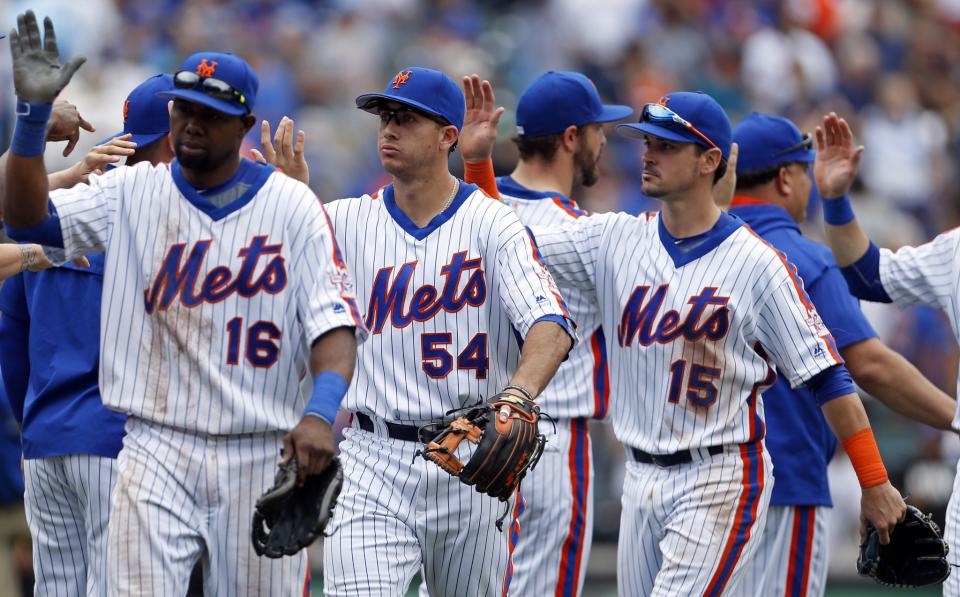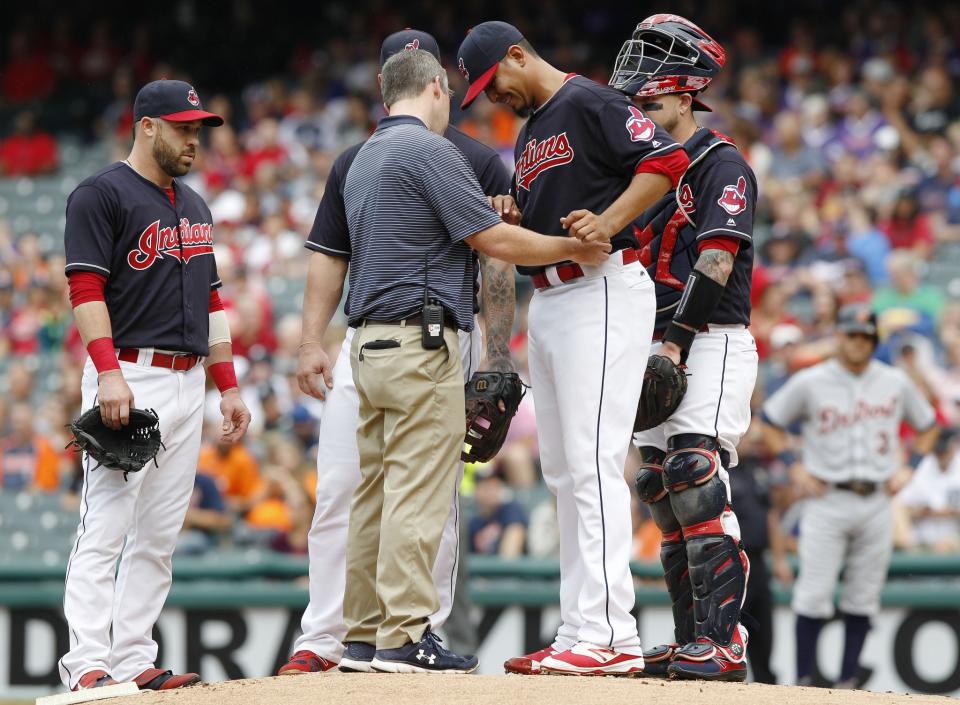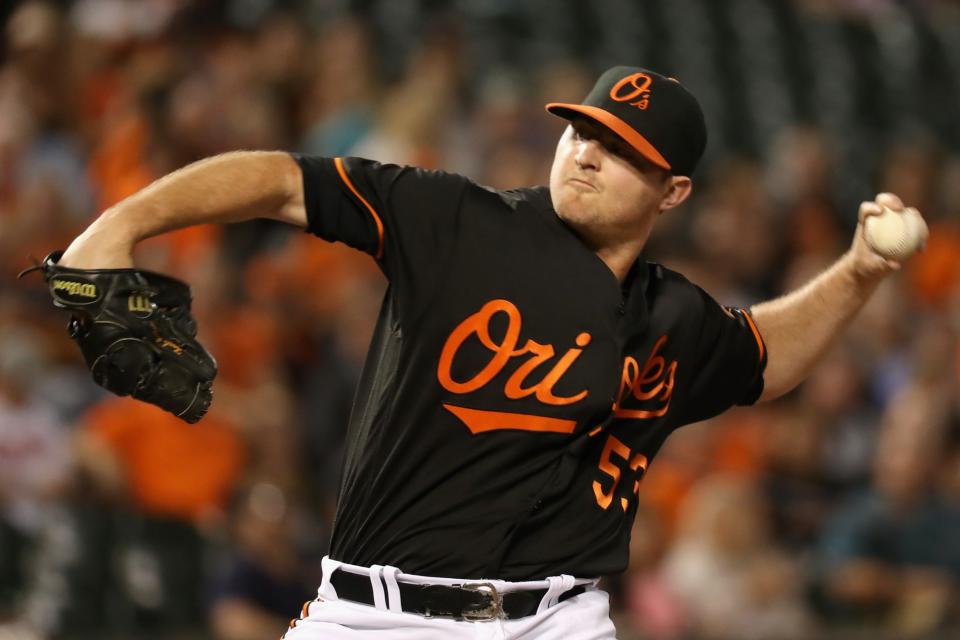The epic collapse of the San Francisco Giants
Bruce Bochy, who this decade has won three World Series for a franchise that in its previous 52 years of existence won exactly zero, got booed Saturday. This is what it has come to. All the exasperation and weariness distilled into a single moment, a single move that felt so microcosmic of the previous two months that instinct took over and San Francisco Giants fans, tired of it all, rained fury on their Hall of Fame manager.
Here came Santiago Casilla, again. And there went a lead, again. They’d seen this act before. Three times in the last two weeks, actually, two weeks that looked a lot like the previous two months, which looked pretty much unlike anything anyone ever had seen in baseball.

On July 15, the day the second half of the season began, the San Francisco Giants owned the best record in baseball at 57-33, a pace that had them on the path to 103 victories. Ever since, they are 22-37, the worst post-All-Star break record in baseball, one that over a full season would equal 102 losses. The first-half Giants were the Cubs, the second-half Giants are the Twins, and they’re essentially the exact same team. This does not make any sense.
So they boo, because they’d seen this screenplay before, in which Bochy, heretofore bullpen whisperer, entrusts a game in Casilla, only to see him take the mound with a gas can, a Bic and the comportment of a habitual pyromaniac. On cue, he set ablaze Saturday’s game, officially his eighth blown save of the season, though that doesn’t even address the one 10 days earlier, in which he came in for a save and was yanked off the stage before he could do any more damage, like Bochy was Sandman Sims.
For two months, the Giants have actively sabotaged themselves. Their longest winning streak lasted three games, and that came against the Arizona Diamondbacks, which means it should count for, like, 1½ games probably. They’ve had losing streaks of three, three, four, four and six games. The Giants have blown a save in five consecutive series. Watching writer Grant Brisbee’s descent into madness – check out the URL on this column – is positively Kurtzian.
And still, after all this, the …
1. San Francisco Giants somehow still control their playoff destiny. Seriously! If the season ended today, they’d be the second wild card team, which speaks to the, uh, quality of the rest of the National League? Yeah. OK. Quality.
Behind them are the St. Louis Cardinals, who needed Casilla’s meltdown Saturday and seven scoreless innings from a pitcher making his third major league start Sunday to pull within a game of the Giants. Looming is an absolute treat Monday, the sort of game that truly makes it feel like pennant-chase season: Madison Bumgarner vs. Clayton Kershaw at Dodger Stadium.
Even if they somehow can manage to beat Kershaw, Rich Hill and Kenta Maeda back-to-back-to-back, the Giants still would trail the Dodgers by two games. San Francisco’s best hope is a stretch after the Dodgers series in which it’s scheduled to face Christian Friedrich, Edwin Jackson, Jarred Cosart, Jorge De La Rosa, German Marquez and Tyler Chatwood. The Magnificent Seven it ain’t.
Considering some of the starters to whom the Giants have lost in their swoon – Luis Perdomo and Paul Clemens in the past week were particular beauts – this doesn’t protect them from themselves and an offense with an APB out on Brandon Crawford, Denard Span, Angel Pagan and Joe Panik. That the Giants have allowed a …
2. Jacob deGrom-less New York Mets team – make that a deGrom-, Matt Harvey, Steven Matz-, Zack Wheeler-less Mets team – to creep ahead of it into lead position in the wild-card race is some kind of sorcery. On Aug. 19, the day of the Mets’ lowest moment, exactly a month ago, the Giants held an eight-game lead on New York. Now the Mets are 80-69, the Giants 79-70 and the Cardinals 78-71, and there are 13 games left until the music stops.

Even without all those injured pitchers, the Mets have carved out the best September record in baseball at 11-4. They scored nine runs against the Twins over the weekend and still swept the three-game series. And though win-loss record for individual pitchers isn’t wholly indicative of quality, the 13 pitchers from Atlanta, Philadelphia and Miami whom New York is slated to face over the next two weeks are a combined 54-92 – or pretty much second-half Giants.
The upshot is a Mets team that a month ago looked dead today – a Mets team that just got Lucas Duda back, that’s still without all those pitchers and Neil Walker and David Wright, that is batting infielder T.J. Rivera second – now finds itself in the catbird’s seat to host the wild-card game Oct. 5. And it’s no surprise that Noah Syndergaard is lined up to throw on full rest that day, either.
Matz may return, though even if he does, the Mets recognize their playoff rotation would start with Bartolo Colon and likely feature Seth Lugo in Game 2 before returning to Syndergaard in Game 3. On-the-fly pitching changes are nothing new to October-ready teams, and the season-ending injury this week to …
3. Carlos Carrasco gave the Cleveland Indians even more experience in trying to figure out how to weather the losses of him and Danny Salazar, their second- and third-best starters and the theoretical anchors of any playoff push. The Indians are not as good without Carrasco and Salazar, and yet they ought be applauded for the creativity with which they’re looking to solve the problem.

Cleveland’s internal discussions have included the possibility of a three-man playoff rotation. Corey Kluber, looking to win his second AL Cy Young in three years, would lead the staff and rubber-armed Trevor Bauer would follow him. What Cleveland would do with the third spot is particularly interesting. One possibility: piggybacking Josh Tomlin and Mike Clevinger, with each perhaps on a 60-pitch limit to allow them to return on short rest. They’re a dizzying complement: Tomlin sitting at 88 mph and throwing his fastball and cutter 80 percent of the time, Clevinger with 94-mph gas and a changeup as hard as Tomlin’s fastball.
Back that with a devastating Andrew Miller-Cody Allen-Dan Otero-Bryan Shaw-Shawn Armstrong bullpen, and even if it’s not Carrasco and Salazar, it’s enough to back Cleveland’s surprising offense, which has scored the second most runs in the AL. Kansas City won a World Series last year with its bullpen, and …
4. Zach Britton would love to do the same with Baltimore this year. The return of Darren O’Day helps. Brad Brach and Mychal Givens are funky and effective. And left-hander Donnie Hart is 14⅔ innings into his major league career and still sports a 0.00 ERA.
He’s one of the few in Major League Baseball who can say he’s got a better ERA than Britton. His dipped to 0.59 on Sunday, when he notched his 45th save in 45 tries. Those two numbers alone – the first looking to break a record for lowest ERA in a season, the latter with that sparkle of perfection – have sold the idea of Britton as a Cy Young candidate. And because of a less-than-desirable crop of starting pitchers, it’s an idea gaining traction.
Here’s the thing: Britton isn’t exactly unique. His numbers next to another dominant AL reliever:

That other reliever is Andrew Miller, and the only thing separating him from a better season than Britton are the home runs. It’s a significant difference and a fair point to make. Otherwise, Miller has been damn near Britton’s equal. His name is nowhere near the Cy Young ballot, let alone atop it.

Sometimes it’s easy to forget how hard it is to throw 200 innings in a season. Britton himself would attest to that. He was a starter once upon a time, and he was young and middling. A move to the bullpen in 2014 unleashed one of the two or three best relievers in baseball. Which is not to say that Britton’s failure as a starter in any way delegitimizes his candidacy for the award. It’s more to remind that Britton’s job simply isn’t as demanding, and that workload almost always makes up for sparing dominance.
Of Britton’s 45 saves, 14 have come in one-run situations, 16 up two runs, 13 ahead three and a pair with a four-run advantage. He’s still destroying the field in Win Probability Added, but for those who care to go metric-hunting, he’s behind a dozen starters in Baseball-Reference’s WAR, including teammates Kevin Gausman and Chris Tillman, and even two AL relievers, New York’s Dellin Betances and Miller, in FanGraphs’ WAR.
Absent a clearer choice, Britton may become the first reliever since Eric Gagne in 2003 and first AL reliever since Dennis Eckersley in 1992 to win the Cy Young. Never mind that …
5. Edwin Diaz has almost the exact Fielding Independent Pitching number as Britton. Or that in the second half, hitters have slashed .165/.243/.206 against him, compared to Britton’s .157/.231/.193. Again, this is not to put down Britton so much as to say, yes, he does have peers, as opposed to crowning him demigod of relievers so mighty he will win an award for the best pitcher in a league based on all of 65 or so innings.
Anyway, Diaz. If you haven’t heard of him, blame the Seattle Mariners’ West Coast-heavy schedule and the fact that the 22-year-old didn’t join the team until early June or take over as closer until two months later. All Diaz has done in 45 innings this season is strike out 77, a strikeout rate that would rank him eighth in baseball history for a relief pitcher with at least 40 innings.
The Mariners are one of those how-are-they-doing-what-they’re-doing teams, with a top-10 scoring offense and ERA. For one, the usual suspects: Robinson Cano, Nelson Cruz and the criminally underrated Kyle Seager, whose brother Corey may for years be tied to …
6. Gary Sanchez should they both win Rookie of the Year. Seager’s is a fait accompli. Sanchez’s may be a long shot, but is he ever making a case. In 41 games, Sanchez has 16 home runs. His rocket down the line at Fenway Park on Sunday night left the bat at more than 110 mph, the latest in a seemingly never-ending line of balls Sanchez hits with authority.
Now, batted-ball exit velocity does not equal excellence. Sanchez’s average exit velo is 94.2 mph, good for ninth in baseball. Among those in front of him: Teammate Aaron Judge, whose swing-and-miss skills are scary, along with Keon Broxton, Domingo Santana, Tyler Flowers and Pedro Alvarez. There’s also Cruz and Giancarlo Stanton, though, and if Sanchez finds himself in their level of company, the Yankees will have a homegrown annual All-Star behind the plate.
Beating Michael Fulmer for Rookie of the Year may be an excessive ask. Fulmer is approaching 150 innings. Sanchez barely has 150 at-bats. But that .327/.393/.698 slash line, those 16 homers, the who storyline of the new Bronx Bomber, may be enough to convince voters that Sanchez is the second-best rookie of all, behind Seager. Of course, then they’d be forgetting …
7. Trea Turner and his Sanchez-with-speed numbers since joining the Washington Nationals. Turner is slashing .355/.377/.590 with 11 home runs and 27 stolen bases in 268 plate appearances. Narrow it down to September, and 23-year-old Turner turns into Mechagodzilla: .386/.411/.729.
Thrown in the above-average glove for a kid playing center field for the first time ever, and it makes the sting that much worse for two teams: The San Diego Padres, who dealt away Turner and pitcher Joe Ross (not to mention well-regarded prospect Jake Bauers) to the Tampa Bay Rays for a package that included Wil Myers. The Rays then flipped Turner and Ross for Steven Souza Jr. and Travis Ott, a 21-year-old who along with Bauers may represent the Rays’ best chance at salvaging the deal.
Even if Turner won’t win NL Rookie of the Year, he does have a chance to capture some less-prestigious hardware: NL Player of the Month. His counterpart for the first two-thirds of the month, at least, is …
8. Hanley Ramirez and his curtain call-worthy bat. Which just goes to show you: No long-term free agent signing can be deemed a complete bust after one season. Awful though Ramirez’s contract may have been last season, he is a bargain this year at $22 million, just another bat in a lineup of Papi and Betts and Pedroia and Bogaerts and Bradley and Benintendi and Leon and is it me or do the Red Sox look like a really good World Series value at 8/1?
Ramirez certainly isn’t hurting the cause like he did last year, a .249/.291/.426 stink bomb that former GM Ben Cherington wore like a Scarlett H when he got fired. Now Ramirez is up to .294/.364/.517 following a September in which he has launched nine home runs and a million dreams of a … wait for it …
Cubs-Red Sox World Series.
No emoji wears a smile large enough to capture the giddiness that would bring to a sport that could use a nationally compelling World Series. The resurgence of Hanley, the goodbye of Papi, the MVP candidacy of Mookie 30 years after another Mookie’s October to remember. The way the Red Sox are hitting, it’s eminently possible. They’ve scored 106 runs in 16 games this month, more than 6.6 per game, like they’re trotting out a lineup of …
9. Joey Vottos and letting them go to work. Votto went 4 for 4 Sunday, another ho-hum, shoulder-shrugging day at work on a second half that now looks like this: .412/.498/.649. It may well end up as close a post-All-Star Game run to George Brett’s .421/.482/.696 as we’ll see.
Votto’s transformation is staggering. Pre-break, he struck out 88 times in 294 at-bats. Post-break: 211 at-bats, 28 strikeouts. It is surely enough to get him on the back half of some MVP ballots, get his name going in the trade market after it seemed like the possibility of Votto and the $179 million left on his contract after this season ever being dealt was somewhere between none and none.
Oh, and Votto says he doesn’t want to go anywhere. Plus he wields a full no-trade clause as part of the 12-year deal he signed with Cincinnati. Even if the Reds did find a taker and wanted to free up the salary and get back beaucoup prospects, they may well not be able to. That’s the problem with giving out no-trade clauses: Even if they placate the player, they steal any power from the team. And as a team that knows something about losing power, the …
10. San Francisco Giants advise strongly against it. Because sometimes it takes a homer or two to win a close game, and the Giants are not homering and unquestionably not winning games.
Maybe it’s the Curse of Dylan Hernandez, the Los Angeles Times columnist who at the All-Star Game congratulated Giants first baseman Brandon Belt on winning the NL West. Belt didn’t play along so much as sheepishly try to avoid the vortex of Hernandez, but it was futile. He’s batting .223 since the break, and his slugging percentage is down more than 150 points from his first-half mark.
Perhaps it is the home runs, in that opponents have outhomered Giants hitters by more than 25 in the second half. Or that Buster Posey’s power seems to have been sapped, too, by lingering hand injuries – which also may have contributed to the Giants’ caught-stealing rate halving, from 44 percent in first half to 22 percent since.
And, yeah, if you want to blame the bullpen, too, go for it. The Giants actually have only a minus-6 run differential despite their record, and that’s because when they win, they do it in blowouts. Among their 22 wins, there have been ones by nine, eight, seven, seven, six and six runs. San Francisco’s record in one-run games, meanwhile, is 7-15. And in two-run games, it’s 5-8. In three- and four-run games: 4-11.
Every game is close, and they’re losing almost all of the close games. So it’s no wonder the fans now have turned to Derek Law, the Giants’ best reliever all year, as the solution at closer. Never mind that Law is two games removed from a DL stint for an elbow injury, which is bad for any pitcher and really bad for one with a Tommy John scar on his elbow. He may be the best answer, but that doesn’t make him a good one.
There is no good one for the Giants, other than hoping this weekend was the nadir and the next two weeks prove more fruitful. It’s not just Kershaw-Hill-Maeda this week. The Giants get them at home, with Bumgarner-Cueto-Moore opposing them, for the last three games of the season. Little would make the Dodgers happier than not just beating the Giants but doing so in historic fashion.
This collapse, for now, at least, qualifies. It ticks all the important boxes. Huge lead blown? Check. Destroying once and for all the narrative liberties, like the Giants’ even-year mythology? Check. Depressive fan behavior. Check.
A couple wins against the Dodgers is all it takes to change their fortunes. We’re that close to the playoffs, that close to a game in the ninth inning with a one-run lead in which the manager lopes to the mound and hopes to call upon that bullpen magic of the past when he really, truly could use it. Especially if it makes those boos go away.


